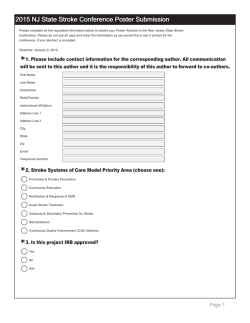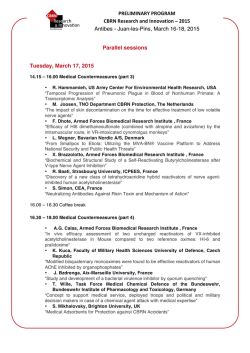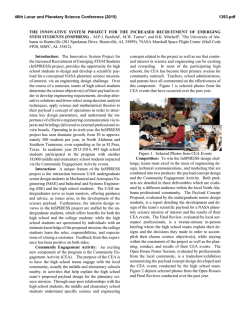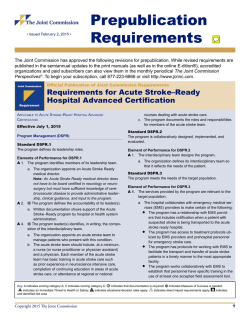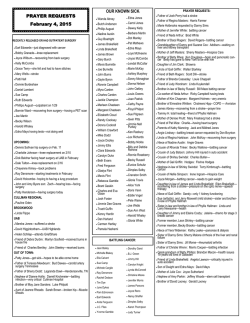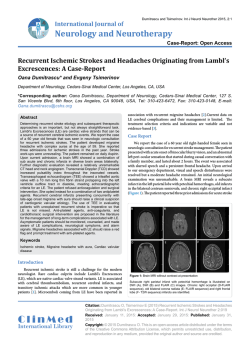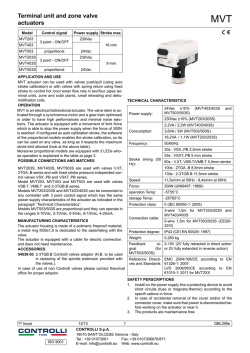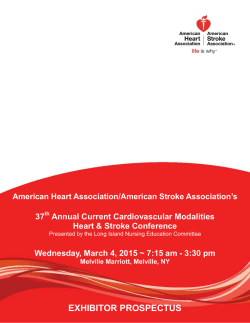
Download Full Text - Harvard University
Clinical Prediction Model Suitable for Assessing Hospital Quality for Patients Undergoing Carotid Endarterectomy The Harvard community has made this article openly available. Please share how this access benefits you. Your story matters. Citation Wimmer, Neil J., John A. Spertus, Kevin F. Kennedy, H. Vernon Anderson, Jeptha P. Curtis, William S. Weintraub, Mandeep Singh, John S. Rumsfeld, Frederick A. Masoudi, and Robert W. Yeh. 2014. “Clinical Prediction Model Suitable for Assessing Hospital Quality for Patients Undergoing Carotid Endarterectomy.” Journal of the American Heart Association: Cardiovascular and Cerebrovascular Disease 3 (3): e000728. doi:10.1161/JAHA.113.000728. http://dx.doi.org/10.1161/JAHA.113.000728. Published Version doi:10.1161/JAHA.113.000728 Accessed February 6, 2015 11:04:54 AM EST Citable Link http://nrs.harvard.edu/urn-3:HUL.InstRepos:13890748 Terms of Use This article was downloaded from Harvard University's DASH repository, and is made available under the terms and conditions applicable to Other Posted Material, as set forth at http://nrs.harvard.edu/urn-3:HUL.InstRepos:dash.current.terms-ofuse#LAA (Article begins on next page) ORIGINAL RESEARCH Clinical Prediction Model Suitable for Assessing Hospital Quality for Patients Undergoing Carotid Endarterectomy Neil J. Wimmer, MD; John A. Spertus, MD, MPH; Kevin F. Kennedy, MS; H. Vernon Anderson, MD; Jeptha P. Curtis, MD; William S. Weintraub, MD; Mandeep Singh, MD, MPH; John S. Rumsfeld, MD, PhD; Frederick A. Masoudi, MD, MSPH; Robert W. Yeh, MD, MSc Background-—Assessing hospital quality in the performance of carotid endarterectomy (CEA) requires appropriate risk adjustment across hospitals with varying case mixes. The aim of this study was to develop and validate a prediction model to assess the risk of in-hospital stroke or death after CEA that could aid in the assessment of hospital quality. Methods and Results-—Patients from National Cardiovascular Data Registry (NCDR)’s Carotid Artery Revascularization and Endarterectomy (CARE) Registry undergoing CEA without acute evolving stroke from 2005 to 2013 were included. In-hospital stroke or death was modeled using hierarchical logistic regression with 20 candidate variables and accounting for hospital-level clustering. Internal validation was achieved with bootstrapping; model discrimination and calibration were assessed. A total of 213 (1.7%) primary end point events occurred during 12 889 procedures. Independent predictors of stroke or death included age, prior peripheral artery disease, diabetes mellitus, prior coronary artery disease, having a symptomatic carotid lesion, having a contralateral carotid occlusion, or having New York Heart Association Class III or IV heart failure. The model was well calibrated and demonstrated moderate discriminative ability (c-statistic 0.65). The NCDR CEA score was then developed to support simple, prospective risk quantification in the clinical setting. Conclusions-—The NCDR CEA score, comprising 7 clinical variables, predicts in-hospital stroke or death after CEA. This model can be used to estimate hospital risk-adjusted outcomes for CEA and to assist with the assessment of hospital quality. ( J Am Heart Assoc. 2014;3:e000728 doi: 10.1161/JAHA.113.000728) Key Words: carotid endarterectomy • risk prediction • stroke C arotid endarterectomy (CEA) reduces stroke risk in both symptomatic and asymptomatic patients with carotid atherosclerosis compared with medical therapy.1–4 While a number of studies have considered many potential risk factors for the development of adverse events after CEA, only From the Brigham and Women’s Hospital and Harvard Medical School, Boston, MA (N.J.W.); Saint Luke’s Mid-America Heart Institute, Kansas City, MO (J.A.S., K.F.K.); University of Texas Health Science Center, Houston, TX (H.V.A.); Yale University School of Medicine, New Haven, CT (J.P.C.); Christiana Health Care, Newark, DE (W.S.W.); Mayo Clinic, Rochester, MN (M.S.); Denver Veterans Affairs Medical Center, Denver, CO (J.S.R.); University of Colorado, Aurora, CO (F.A.M.); Massachusetts General Hospital and Harvard Medical School, Boston, MA (R.W.Y.). An accompanying Appendix S1 is available at http://jaha.ahajournals.org/ content/3/3/e000728/suppl/DC1 Correspondence to: Robert W. Yeh, MD, MSc, Cardiology Division, GRB 800, Massachusetts General Hospital, 55 Fruit Street, Boston, MA 02114. E-mail: [email protected] Received December 12, 2013; accepted April 7, 2014. ª 2014 The Authors. Published on behalf of the American Heart Association, Inc., by Wiley Blackwell. This is an open access article under the terms of the Creative Commons Attribution-NonCommercial License, which permits use, distribution and reproduction in any medium, provided the original work is properly cited and is not used for commercial purposes. DOI: 10.1161/JAHA.113.000728 a few have offered overall risk assessments for patients considering CEA.5–12 These studies have been limited to reporting experience in Medicare populations,8 in clinical trial populations,7,9 in asymptomatic patients only,8,11 in a smaller number of centers in Canada before aggressive lipid-lowering and antiplatelet therapy was standard,6 or based on administrative data sets.12 The National Cardiovascular Data Registry (NCDR), including the Carotid Artery Revascularization and Endarterectomy (CARE) Registry, provides innovative platforms to assess hospital quality. Sponsored by the American College of Cardiology Foundation in conjunction with the Society for Cardiovascular Angiography and Interventions, Society of Interventional Radiology, American Academy of Neurology, American Association of Neurological Surgeons/Congress of Neurological Surgeons, Society for Vascular Medicine, and Society of Vascular and Interventional Neurology, the CARE Registry was designed to create a national surveillance system to assess prevalence and outcomes of patient undergoing carotid revascularization. As of November 2013, 130 hospitals participate in the registry.13 Participating hospitals receive quarterly reports with information pertaining Journal of the American Heart Association 1 The NCDR Carotid Endarterectomy Risk Score Wimmer et al Methods The CARE Registry enrolls patients with carotid stenosis who have undergone revascularization with either CEA or carotid artery stenting (CAS).15 Between April 2005 and July 2013, the registry accrued data from 12 889 CEA procedures performed at 60 hospitals. Data elements and definitions are listed at https://www.ncdr.com/webncdr/care/home/datacollection. Detailed quality checks are implemented before incorporation of data into the registry.16 A waiver of written informed consent and authorization for this study was granted by the Chesapeake Research Review Incorporated Institutional Review Board. To maximize the applicability of the findings, all except those undergoing CEA for acute evolving stroke were included. The primary outcome of interest was the occurrence of in-hospital stroke or death. Stroke was defined as a new neurologic deficit persisting for at least 24 hours after the procedure. Outcomes were abstracted by trained data collectors. Statistical Analyses We examined broad ranges of variables related to sociodemographic characteristics, cardiovascular history, and neurologic history based on clinical experience and understanding of the literature. We conducted bivariate comparisons of characteristics of patients with or without the outcome of interest (Table 1) by using v2 tests for dichotomous variables and t tests for continuous variables. We then generated a logistic model for the primary end point conditioned on clinical variables.17 Variables were selected using backward elimination of 20 variables using a criterion of P<0.05 to DOI: 10.1161/JAHA.113.000728 remain. Model coefficients were then refit using a hierarchical generalized linear model accounting for clustering by hospital (see supplemental online Appendix). The performance of a prediction model within a sample of data may overestimate the true performance of the model within the broader population. The difference between the “apparent performance” and the true performance is known as “optimism.”18 The extent of optimism of prespecified models can be estimated for similar patient populations using internal validation techniques such as bootstrapping. After fitting the model, we conducted internal validation by refitting the model in 1000 bootstrap samples with replacement. Measures of model performance were corrected for optimism, and the final model was recalibrated based on a “shrinkage” factor derived from the calibration slope.17 To further assess calibration, we fitted a smoothed line showing the relationship between predicted and observed risk of inhospital stroke or death based on the final model.17 This method has less variability and less potential bias compared with traditional split-sample validation and k-fold crossvalidation.19 To assess variability in risk-adjusted event rates among hospitals, we estimated the “predicted”-to-expected ratio of in-hospital stroke or death (or the standardized adverse event ratio) for each hospital based on its observed case mix.20 To support routine clinical use, we developed a risk score based on a points system with weights based on the coefficients in the final clinical model.21 Values of P<0.05 (2-tailed) were considered statistically significant. Statistical analyses were performed using SAS 9.2 (SAS Institute) and R. Results There were a total of 213 (1.7%) in-hospital stroke or death events after 12 889 CEA procedures. Stroke occurred in 179 (1.4%) and death occurred in 52 (0.4%) patients. Of the strokes, 124 (69.2%) were ipsilateral to the revascularized artery. Bivariate analysis (Table 1) demonstrated that individuals who developed in-hospital stroke or death were older and were more likely to have peripheral artery disease (PAD), significant coronary artery disease, recent myocardial infarction, or congestive heart failure. They were also more likely to have a tracheostomy present or have preexisting laryngeal nerve palsy. Patients who developed in-hospital stroke or death were more likely to have had a prior ischemic stroke, were more likely to be symptomatic from the target lesion, or were more likely to have a contralateral carotid occlusion. Multivariable Model After multivariable regression, 7 variables were retained in the final model (Table 2). These variables included age, PAD, Journal of the American Heart Association 2 ORIGINAL RESEARCH to number of procedures performed, patient characteristics, and measures of quality including discharge medication prescriptions and crude rates of complications such as in-hospital stroke and death. However, because of differences in case mix among hospitals, differences in crude adverse event rates may be a reflection of differences in patient complexity, particularly with respect to clinical features that strongly influence outcomes. While most attempts to assess hospital procedural quality have relied on administrative claims data,14 observational registries that include prospectively collected clinical data such as the CARE Registry afford the opportunity to create validated, clinically based prediction models to serve as the basis for risk adjustment for hospital quality reports. In this report, we used the CARE Registry to develop and validate a preprocedural risk model and risk score that will be used to provide feedback on risk-adjusted outcomes after CEA to participating hospitals to promote quality improvement. The NCDR Carotid Endarterectomy Risk Score Wimmer et al ORIGINAL RESEARCH Table 1. Baseline Clinical Characteristics Total Stroke or Death No Stroke or Death (N=12 889) (n=213) (n=12 676) Age, y 70.8Æ10.6 72.9Æ10.1 70.8Æ10.6 0.004 Age ≥80 y 2459 (19.1%) 55 (25.8%) 2404 (19.0%) 0.012 Male 7603 (59.0%) 116 (54.5%) 7487 (59.1%) 0.175 7603 (59.0%) 116 (54.5%) 7487 (59.1%) 0.175 72.4Æ30.8 70.8Æ26.0 72.4Æ30.9 0.477 Characteristic White 2 GFR, mL/min per 1.73 m 2 P Value GFR<30, mL/min per 1.73 m or current dialysis 568 (4.4%) 9 (4.2%) 559 (4.4%) 0.896 Current dialysis 216 (1.7%) 5 (2.3%) 211 (1.7%) 0.411 Tobacco use 9307 (72.2%) 149 (70.0%) 9158 (72.2%) 0.459 Hypertension 11 526 (89.4%) 197 (92.5%) 11 329 (89.4%) 0.143 Dyslipidemia 10 502 (81.5%) 166 (77.9%) 10 336 (81.5%) 0.178 Peripheral artery disease 3979 (30.9%) 85 (39.9%) 3894 (30.7%) 0.004 Diabetes mellitus 4518 (35.1%) 91 (42.7%) 4427 (34.9%) 0.018 Chronic lung disease 2826 (21.9%) 60 (28.2%) 2766 (21.8%) 0.026 Home oxygen 404 (14.4%) (N=10 062) 8 (13.3%) (n=153) 396 (14.5%) (n=9909) 0.785 Major surgery planned within 8 wk 471 (3.7%) 24 (11.3%) 447 (3.5%) <0.001 Type of major surgery 0.002 Cardiac 305 (65.0%) 22 (95.7%) 283 (63.5%) Vascular 99 (21.1%) 0 (0.0%) 99 (22.2%) Other 65 (13.9%) 1 (4.3%) 64 (14.3%) (N=12 416) (n=189) (n=12 227) Previous neck radiation 115 (0.9%) 5 (2.3%) 110 (0.9%) 0.042 Previous neck surgery 115 (0.9%) 5 (2.3%) 110 (0.9%) 0.042 Previous laryngeal nerve palsy No 0.003 12 842 (99.7%) 209 (98.1%) 12 633 (99.7%) Yes, right 25 (0.2%) 2 (0.9%) 23 (0.2%) Yes, left 14 (0.1%) 2 (0.9%) 12 (0.1%) Ischemic heart disease 5486 (42.6%) 105 (49.3%) 5381 (42.5%) 0.046 Two or more coronary arteries with stenosis ≥70% (LAD, LCx, RCA) 2890 (22.7%) 61 (29.3%) 2829 (22.6%) 0.021 Left main coronary stenosis ≥50% 521 (4.1%) 19 (9.2%) 502 (4.0%) <0.001 Cardiac history MI within 6 wk 181 (1.4%) 10 (4.7%) 171 (1.3%) <0.001 Angina CCS Angina Class III or IV within 6 wk 306 (2.4%) 15 (7.0%) 291 (2.3%) <0.001 History of heart failure 1221 (9.5%) 36 (16.9%) 1185 (9.4%) <0.001 NYHA Class III or IV within 6 wk 306 (2.4%) 15 (7.0%) 291 (2.3%) <0.001 NYHA Class III/IV or LVEF ≤35% 626 (4.9%) 23 (10.8%) 603 (4.8%) <0.001 LVEF assessed preprocedure 6816 (52.9%) 139 (65.3%) 6677 (52.7%) <0.001 LVEF ≤35% 385 (3.0%) 14 (6.6%) 371 (2.9%) 0.002 History of atrial fibrillation/flutter 1439 (11.2%) 32 (15.0%) 1407 (11.1%) 0.072 Moderate to severe aortic stenosis 325 (2.5%) 12 (5.6%) 313 (2.5%) 0.004 Moderate to severe mitral stenosis 78 (0.6%) 3 (1.4%) 75 (0.6%) 0.139 Continued DOI: 10.1161/JAHA.113.000728 Journal of the American Heart Association 3 The NCDR Carotid Endarterectomy Risk Score Wimmer et al ORIGINAL RESEARCH Table 1. Continued Characteristic Total Stroke or Death No Stroke or Death P Value Mechanical aortic or mitral valve 210 (1.6%) 5 (2.3%) 205 (1.6%) 0.402 Permanent pacemaker or ICD 657 (5.1%) 10 (4.7%) 647 (5.1%) 0.786 1 193 (1.5%) 1 (0.5%) 192 (1.5%) 2 1432 (11.2%) 17 (8.0%) 1415 (11.2%) 3 8660 (67.5%) 111 (52.4%) 8549 (67.8%) 4 2511 (19.6%) 81 (38.2%) 2430 (19.3%) 5 33 (0.3%) 2 (0.9%) 31 (0.2%) <0.001 ASA physical classification grade Neurologic history and risk factors Dementia or Alzheimer’s disease 307 (2.4%) 11 (5.2%) 296 (2.3%) 0.007 History of seizure or seizure disorder 261 (2.0%) 4 (1.9%) 257 (2.0%) 1.000 Previous carotid revascularization 1979 (15.4%) 34 (16.0%) 1945 (15.3%) 0.805 Prior CEA 1883 (14.6%) 31 (14.6%) 1852 (14.6%) 0.982 Prior CAS 122 (0.9%) 4 (1.9%) 118 (0.9%) 0.143 Prior ipsilateral CAS 20 (0.2%) 0 (0.0%) 20 (0.2%) 1.000 Prior ipsilateral CEA 240 (1.9%) 2 (0.9%) 238 (1.9%) 0.445 5484 (42.6%) 116 (54.5%) 5368 (42.4%) <0.001 Prior TIA 3353 (26.0%) 67 (31.5%) 3286 (25.9%) 0.068 Prior ischemic stroke 1752 (13.6%) 43 (20.2%) 1709 (13.5%) 0.005 Prior hemorrhage or hemorrhagic stroke 78 (0.6%) 2 (0.9%) 76 (0.6%) 0.370 Neurologic event(s) preprocedure Procedure information Target carotid vessel 0.507 Right 6523 (50.6%) 103 (48.4%) 6420 (50.6%) Left 6366 (49.4%) 110 (51.6%) 6256 (49.4%) Anesthesia type 0.058 General 11 671 (90.6%) 201 (94.4%) 11 470 (90.5%) Local 1210 (9.4%) 12 (5.6%) 1198 (9.5%) Urgent cardiac surgery within 30 d 431 (3.4%) 24 (11.5%) 407 (3.2%) <0.001 Target lesion symptomatic within 6 mo 4510 (35.0%) 101 (47.4%) 4409 (34.8%) <0.001 Restenosis in target vessel after prior CAS 228 (1.8%) 2 (0.9%) 226 (1.8%) 0.594 Restenosis in target vessel after prior CEA 228 (1.8%) 2 (0.9%) 226 (1.8%) 0.594 Contralateral carotid artery occlusion 686 (5.3%) 24 (11.3%) 662 (5.2%) <0.001 Fibromuscular dysplasia of carotid artery 21 (0.2%) 3 (1.4%) 18 (0.1%) 0.005 GFR indicate glomerular filtration rate; LAD, left anterior descending coronary artery; LCx, left circumflex artery; RCA, right coronary artery; MI, myocardial infarction; CCS, Canadian Cardiovascular Society; NYHA, New York Heart Association; LVEF, left ventricular ejection fraction; ICD, implantable cardioverter defibrillator; ASA, American Society of Anesthesiologists; CEA, carotid endarterectomy; CAS, carotid artery stenting; TIA, transient ischemic attack. history of diabetes mellitus, history of myocardial infarction within 6 weeks, symptomatic target lesion within 6 months, contralateral carotid occlusion, and a history of New York Heart Association Class III or IV heart failure within 6 weeks. The patient characteristics most strongly associated with inhospital stroke or death in the final model were a history of recent myocardial infarction (odds ratio [OR] 2.66, 95% CI DOI: 10.1161/JAHA.113.000728 1.89 to 3.74), the presence of a contralateral carotid stenosis (OR 2.27, 95% CI 1.83 to 2.81), for a recent history of New York Heart Association Class III or IV heart failure (OR 2.39, 95% CI 1.78 to 3.19). This model was found to have a c-statistic of 0.65, demonstrating moderate discrimination. The model was well calibrated (Hosmer-Lemeshow P=0.48, Figure 1). Journal of the American Heart Association 4 The NCDR Carotid Endarterectomy Risk Score Wimmer et al ORIGINAL RESEARCH Table 2. Multivariable Predictors of In-Hospital Stroke or Death, N=12 889 b-Coefficient SE t Value P Value Intercept À6.1609 0.5974 À10.31 <0.0001 Age (per 10 y) 0.2321 0.07026 3.30 0.0010 Odds Ratio (95% CI) 1.26 (1.18 to 1.35) Peripheral artery disease 0.3353 0.1386 2.42 0.0156 1.40 (1.22 to 1.61) Diabetes mellitus 0.3167 0.1349 2.35 0.0189 1.37 (1.20 to 1.57) MI within 6 weeks 0.9788 0.3408 2.87 0.0041 2.66 (1.89 to 3.74) Target lesion symptomatic in prior 6 months 0.5374 0.1354 3.97 <0.0001 1.71 (1.49 to 1.96) Contralateral carotid occlusion 0.8177 0.2143 3.82 0.0001 2.27 (1.83 to 2.81) NYHA Class III/IV 0.8694 0.2918 2.98 0.0029 2.39 (1.78 to 3.19) MI, myocardial infarction; NYHA, New York Heart Association. Integer-Based Scoring System Based on the multivariable model, an integer-based scoring system (the NCDR CEA score) was built for clinical use (Table 3). Observed rates of death or stroke are shown as a function of the point total on the integer scoring system (Figure 2). Risk-Standardized Event Rates by Hospital Using the multivariable model, standardized ratios of inhospital stroke or death for each hospital were generated by hospital and were plotted in Figure 3. These ratios varied from 0.64 to 2.10, suggesting differences in CEA outcomes among the registry hospitals not attributable to observable differences in case mix. Discussion Using a large population of patients undergoing CEA in the United States, we developed and validated a risk model and a risk score that predicts in-hospital stroke and death after CEA. The risk factors we identified have been previously described by other investigators to increase risk of adverse events after CEA, either alone or in combination with other factors.22,23 Hospital Quality Assessment With growing emphasis on public outcome reporting, we believe that risk models based on easily collected clinical Table 3. NCDR CEA Risk Score System Variable Points Age, y <50 0 50 to 59 2 60 to 69 4 70 to 79 6 80 to 89 8 ≥90 10 Peripheral artery disease 3 Diabetes mellitus 3 MI within 6 weeks 8 Figure 1. Observed vs predicted probability of in-hospital Target lesion symptomatic in previous 6 months 5 stroke or death. This calibration plot depicts observed (yaxis) vs predicted (x-axis) in-hospital stroke or death rates for patients undergoing carotid endarterectomy. Differences between observed and predicted event rates were small across all levels of risk (Hosmer-Lemeshow P=0.52). Contralateral carotid occlusion 7 NYHA Class III/IV 7 DOI: 10.1161/JAHA.113.000728 NCDR indicates National Cardiovascular Data Registry; CEA, carotid endarterectomy; MI, myocardial infarction; NYHA, New York Heart Association. Journal of the American Heart Association 5 The NCDR Carotid Endarterectomy Risk Score Wimmer et al ORIGINAL RESEARCH Figure 2. Stroke or death rates based on cumulative risk score. Observed stroke or death rates are shown as a function of the total number of points on the NCDR CEA risk score. CEA indicates carotid endarterectomy; MACE, combined endpoint of stroke or death; NCDR, National Cardiovascular Data Registry. Figure 3. Histogram of hospitals according to risk-standardized factors will have an increasingly important place in the assessment and reporting of health care quality. The NCDR CEA Risk Score includes relevant clinical factors that are likely not available through traditional administrative data sets. Inclusion of these clinical factors in the risk model improves the face validity of these tools for clinicians and underscores the importance of clinical registries in measuring hospital quality. The variability in standardized adverse event ratios observed across participating hospitals provides evidence that such models may be useful to hospitals in efforts to benchmark performance against other hospitals and for lower-performing hospitals to initiate efforts to improve outcomes. NCDR CEA Risk Score in the Context of Previous Risk Stratification Models This risk score was developed in a large data set (>10 000 procedures) of CEA in both symptomatic and asymptomatic patients from a broad range of hospitals across the United States. The patient population was not limited to Medicare beneficiaries or those enrolled in clinical trials. We also note the overall low event rates in this population of patients. This could indicate evolution of treatment of this patient population (including improved background medical therapy, surgical techniques, anesthesia care, etc); it could be related to patient selection in the data set; or it could be related to the self-reported nature of the data without routine, independent neurologist assessment in every patient. Changes in surgical and perioperative practice, indicated by changing rates of adverse events over time, underscore the need for ongoing surveillance and, when necessary, DOI: 10.1161/JAHA.113.000728 event rates. Risk standardized stroke/death rates indicate inhospital stroke or death. updating risk prediction algorithms that are intended for clinical practice. Importantly, this risk score was developed accounting for natural clustering in the data by hospital site and can be used for assessments of hospital quality at the site level. Study Limitations Several limitations warrant discussion. First, prediction of inhospital stroke or death is limited to the in-hospital period and does not predict long-term outcomes in these patients as this information is not available in CARE. Second, we did not adjust for all variables that influence CEA-related risk, as indicated by the moderate discriminative ability of the model. For instance, the stenosis severity of the carotid lesion and the overall level of disability of the patient before the index procedure are not well characterized in CARE and thus have not been captured in the model. However, models with imperfect patient-level discrimination are still useful for the assessment of hospital quality without introducing bias so long as unobserved variables strongly associated with inhospital stroke or death are similarly prevalent across participating hospitals.20 The stroke end point was not adjudicated beyond reporting by individual sites and patients were not routinely tested by a neurologist in a standardized way postprocedure. The CARE Registry thus could underreport minor strokes, as has occurred in other studies. However, the overall rates of death and stroke in our study at 30 days were similar to those observed in both the Journal of the American Heart Association 6 The NCDR Carotid Endarterectomy Risk Score Wimmer et al Conclusions We developed and internally validated a risk model to predict in-hospital stroke or death after CEA using data from the CARE Registry. The model will be used to support hospital comparisons of risk-adjusted outcomes among the >100 participating hospitals, allowing for accurate benchmarking of hospital performance or quality improvement efforts for CEA. In addition, it may provide valuable information about procedural risk for patients considering this therapy. Sources of Funding This research was supported by the American College of Cardiology Foundation’s NCDR. The views expressed in this manuscript represent those of the author(s) and do not necessarily represent the official views of the NCDR or its associated professional societies identified at www.ncdr.com. Partners and Sponsors: CARE Registry is an initiative of the American College of Cardiology Foundation (ACCF), The Society for Cardiovascular Angiography and Interventions, the Society of Interventional Radiology, the American Academy of Neurology, the American Association of Neurological Surgeons/Congress of Neurological Surgeons, the Society for Vascular Medicine, and the Society of Vascular and Interventional Neurology. 4. Halliday A, Mansfield A, Marro J, Peto C, Peto R, Potter J, Thomas D. Prevention of disabling and fatal strokes by successful carotid endarterectomy in patients without recent neurological symptoms: randomised controlled trial. Lancet. 2004;363:1491–1502. 5. van Lammeren GW, Catanzariti LM, Peelen LM, de Vries JP, de Kleijn DP, Moll FL, Pasterkamp G, Bots ML. Clinical prediction rule to estimate the absolute 3year risk of major cardiovascular events after carotid endarterectomy. Stroke. 2012;43:1273–1278. 6. Tu JV, Wang H, Bowyer B, Green L, Fang J, Kucey D. Risk factors for death or stroke after carotid endarterectomy: observations from the Ontario Carotid Endarterectomy Registry. Stroke. 2003;34:2568–2573. 7. Rothwell PM, Warlow CP. Prediction of benefit from carotid endarterectomy in individual patients: a risk-modelling study. European Carotid Surgery Trialists’ Collaborative Group. Lancet. 1999;353:2105–2110. 8. Calvillo-King L, Xuan L, Zhang S, Tuhrim S, Halm EA. Predicting risk of perioperative death and stroke after carotid endarterectomy in asymptomatic patients: derivation and validation of a clinical risk score. Stroke. 2010;41:2786–2794. 9. Rothwell PM, Eliasziw M, Gutnikov SA, Warlow CP, Barnett HJ. Endarterectomy for symptomatic carotid stenosis in relation to clinical subgroups and timing of surgery. Lancet. 2004;363:915–924. 10. Press MJ, Chassin MR, Wang J, Tuhrim S, Halm EA. Predicting medical and surgical complications of carotid endarterectomy: comparing the risk indexes. Arch Intern Med. 2006;166:914–920. 11. Gupta PK, Ramanan B, Mactaggart JN, Sundaram A, Fang X, Gupta H, Johanning JM, Pipinos II. Risk index for predicting perioperative stroke, myocardial infarction, or death risk in asymptomatic patients undergoing carotid endarterectomy. J Vasc Surg. 2013;57:318–326. 12. Bekelis K, Bakhoum SF, Desai A, Mackenzie TA, Goodney P, Labropoulos N. A risk factor-based predictive model of outcomes in carotid endarterectomy: the National Surgical Quality Improvement Program 2005–2010. Stroke. 2013;44:1085–1090. 13. Masoudi FA, Ponirakis A, Yeh RW, Maddox TM, Beachy J, Casale PN, Curtis JP, De Lemos J, Fonarow G, Heidenreich P, Koutras C, Kremers M, Messenger J, Moussa I, Oetgen WJ, Roe MT, Rosenfield K, Shields TP Jr, Spertus JA, Wei J, White C, Young CH, Rumsfeld JS. Cardiovascular care facts: a report from the National Cardiovascular Data Registry: 2011. J Am Coll Cardiol. 2013;62: 1931–1947. 14. Krumholz HM, Wang Y, Mattera JA, Han LF, Ingber MJ, Roman S, Normand SL. An administrative claims model suitable for profiling hospital performance based on 30-day mortality rates among patients with an acute myocardial infarction. Circulation. 2006;113:1683–1692. 15. White CJ, Anderson HV, Brindis RG, Cates CU, Cohen DJ, Ho K, Hopkins LN, Jaff MR, Koroshetz WJ, Rosenfield KA. The Carotid Artery Revascularization and Endarterectomy (CARE) Registry: objectives, design, and implications. Catheter Cardiovasc Interv. 2008;71:721–725. 16. Messenger JC, Ho KK, Young CH, Slattery LE, Draoui JC, Curtis JP, Dehmer GJ, Grover FL, Mirro MJ, Reynolds MR, Rokos IC, Spertus JA, Wang TY, Winston SA, Rumsfeld JS, Masoudi FA. The National Cardiovascular Data Registry (NCDR) data quality brief: the NCDR Data Quality Program in 2012. J Am Coll Cardiol. 2012;60:1484–1488. Disclosures 17. Harrell FE. Regression Modeling Strategies: With Applications to Linear Models, Logistic Regression, and Survival Analysis. New York, NY: Springer; 2001. Dr Masoudi is senior medical officer of the NCDR. Dr Spertus is principal investigator on a contract from ACCF to analyze the CARE registry. He has an equity position in Health Outcomes Sciences. The other authors report no disclosures. 18. Harrell FE Jr, Lee KL, Califf RM, Pryor DB, Rosati RA. Regression modelling strategies for improved prognostic prediction. Stat Med. 1984;3:143–152. 19. Steyerberg EW, Harrell FE Jr, Borsboom GJ, Eijkemans MJ, Vergouwe Y, Habbema JD. Internal validation of predictive models: efficiency of some procedures for logistic regression analysis. J Clin Epidemiol. 2001;54:774–781. 20. Krumholz HM, Normand SL, Spertus JA, Shahian DM, Bradley EH. Measuring performance for treating heart attacks and heart failure: the case for outcomes measurement. Health Aff (Millwood). 2007;26:75–85. References 1. Endarterectomy for asymptomatic carotid artery stenosis. Executive Committee for the Asymptomatic Carotid Atherosclerosis Study. JAMA. 1995;273: 1421–1428. 2. Barnett HJ, Taylor DW, Eliasziw M, Fox AJ, Ferguson GG, Haynes RB, Rankin RN, Clagett GP, Hachinski VC, Sackett DL, Thorpe KE, Meldrum HE, Spence JD. Benefit of carotid endarterectomy in patients with symptomatic moderate or severe stenosis. North American Symptomatic Carotid Endarterectomy Trial Collaborators. N Engl J Med. 1998;339:1415–1425. 3. Randomised trial of endarterectomy for recently symptomatic carotid stenosis: final results of the MRC European Carotid Surgery Trial (ECST). Lancet. 1998;351:1379–1387. DOI: 10.1161/JAHA.113.000728 21. Sullivan LM, Massaro JM, D’Agostino RB Sr. Presentation of multivariate data for clinical use: the Framingham Study risk score functions. Stat Med. 2004;23:1631–1660. 22. Safian RD. Treatment strategies for carotid stenosis in patients at increased risk for surgery. Prog Cardiovasc Dis. 2011;54:22–28. 23. White CJ. Carotid artery stent placement. JACC Cardiovasc Interv. 2010;3:467–474. 24. Hill MD, Brooks W, Mackey A, Clark WM, Meschia JF, Morrish WF, Mohr JP, Rhodes JD, Popma JJ, Lal BK, Longbottom ME, Voeks JH, Howard G, Brott TG. Stroke after carotid stenting and endarterectomy in the Carotid Revascularization Endarterectomy versus Stenting Trial (CREST). Circulation. 2012; 126:3054–3061. Journal of the American Heart Association 7 ORIGINAL RESEARCH CREST (Carotid Revascularization Endarterectomy versus Stenting Trial) trial and other quality improvement programs.12,24 Finally, this registry was not designed to inform us about patients who were screened but did not have CEA.
© Copyright 2025
